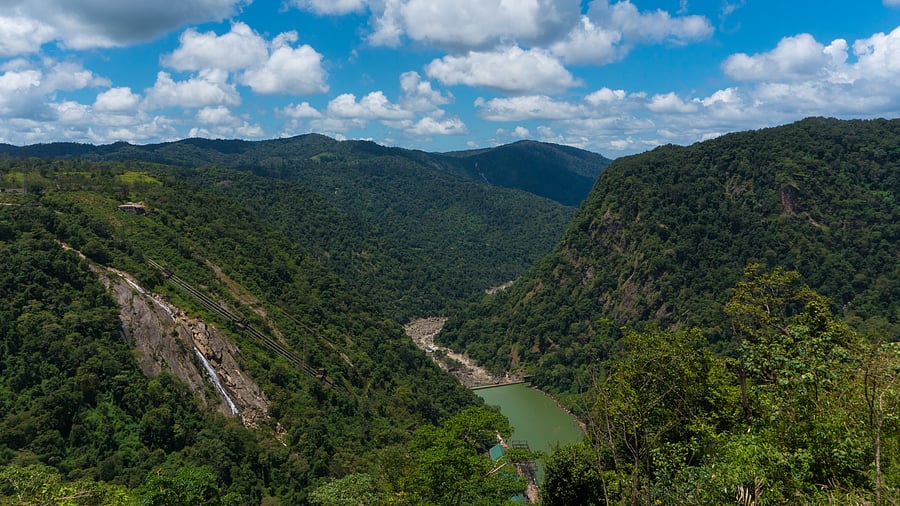
The Sharavathi valley in Sagar taluk of Shivamogga district.
Credit: Special Arrangement
Bengaluru: The controversial Sharavathy pumped-storage project will include blasting and movement of heavy machinery in the Sharavathi Lion Tailed Macaque Sanctuary and felling at least 14,000 trees of evergreen forest in the heart of the Western Ghats.
The 2,000 MW project proposed by the Karnataka Power Corporation Ltd requires 378 acres (153 hectares) of which about 126 acres (52.62 ha) is forest land spread over Honnavar, Shivamogga Wildlife and Sagar divisions.
Within the forest land, 97 acres is part of the Lion Tailed Macaque Sanctuary. The project is estimated to cost Rs 8,005 crore.
Two large tunnels 2.3 km long will draw water from Talakalale dam in the upstream and pump it to the surge shafts connected to the turbines in the power house. The water from the power house will be discharged in the Gerusoppa reservoir downstream with two other tunnels, each about 3.3 km long.
The drawing and discharge tunnels on both sides of the powerhouse will be bult “by drill and blast method”, which involves “controlled” use of explosives to speed up the tunneling work.
The powerhouse complex will be built into a hill. The excavation will be carried out by drill and blast method. “Drilling will be done with two-boom hydraulic jumbo drill using by full face method,” it said.
According to other documents reviewed by DH, the project involves cutting of 13,774 trees belonging to more than 20 species in Honnavar division (Uttara Kannada district). Details of the trees to be felled in Shivamogga wildlife and Sagar divisions were yet to be declared.
“There were differences in the data submitted in the project proposal and the ground position. We have asked the user agency (KPCL) to correct some details on land requirements. Details of tree felling will be available once the agency provides details,” a senior official in the forest department said.
According to the report submitted by the forest department, apart from the lion tailed macaque, leopards, king cobra, sloth bear, Indian mongoose, wild boar, pangolins, Malabar grey hornbill are among the wildlife species to be affected. In Honnavar, two endemic flora, the evergreen tree Syzygium gardneri and the plant Myristica malabarica will be affected along with a similar list of wildlife.
KPCL said nearly half of the 97 acres in the Lion Tailed Macaque Sanctuary will be utilised for underground structures like tunnels, surge chamber and powerhouse. These will not cause “any” disturbance because of the “components being around 500 metres below the surface”, it says. The remaining sanctuary will be utilised for upgrading the existing 6 km road and building a new 4.5 km road.
The company promised to maintain the existing width of the road and during the construction phase, provide streams or water courses and cross over bridges as passage for ground-dwelling animals. “We will limit the canopy disturbance to the minimum and site specific wildlife mitigation measures will be taken up,” Chief Engineer (civil designs) of KPCL stated.
KPCL officials were not available to comment on the felling of trees in the other two divisions.
Sagar-based conservationist Akhilesh Chipli said the project was yet another example of the government’s tunnel vision.
“They are calculating the energy cost and fail to see the cost of the ecological destruction. When will they see the rising man-animal conflicts caused by the Upper Bhadra project? The displacement of hundreds of elephants after the submergence of Anebylu in the backwaters of Linganamakki dam? People in Shettihalli and Bhadra are paying the price for it today,” he said, referring to the disturbance caused by the projects to water security.